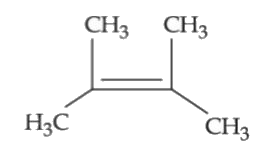The major product formed in the following reaction is :
CH3−CH3∣C∣CH3−C∣OHH−CH3concH2SO4−−−−−−→a few drops Major product




To determine the major product formed in the reaction of the given alcohol with concentrated sulfuric acid, we can follow these steps:
1. Identify the Reactant Structure:
The reactant is a tertiary alcohol with the structure:
CH3−C(CH3)2−CH(OH)−CH3
This means we have a carbon chain with an -OH group on a carbon that is bonded to two methyl groups.
2. Protonation of the Alcohol:
When concentrated sulfuric acid (H₂SO₄) is added, it donates a proton (H⁺) to the hydroxyl (-OH) group of the alcohol. This forms a protonated alcohol:
CH3−C(CH3)2−C+(H)−CH3
The oxygen now has a positive charge, making it a better leaving group.
3. Formation of Carbocation:
The protonated alcohol can lose a water molecule (H₂O), leading to the formation of a carbocation:
CH3−C(CH3)2−C+−CH3
This is a secondary carbocation.
4. Rearrangement to Form a More Stable Carbocation:
The secondary carbocation can rearrange to form a more stable tertiary carbocation. A methyl group from the adjacent carbon can shift to the carbocation:
CH3−C+−C(CH3)2−CH3
This results in a tertiary carbocation.
5. Deprotonation to Form Alkene:
The tertiary carbocation can lose a proton (H⁺) to form an alkene:
CH3−C(CH3)=C−CH3
This results in the formation of an alkene with a double bond between the second and third carbon atoms.
6. Final Product:
The major product of this reaction is:
CH3−C(CH3)=C−CH3
This is an internal alkene, specifically 2-methyl-2-pentene.
Conclusion
The major product formed in the reaction is 2-methyl-2-pentene.
The reactant is a tertiary alcohol with the structure:
CH3−C(CH3)2−CH(OH)−CH3
This means we have a carbon chain with an -OH group on a carbon that is bonded to two methyl groups.
When concentrated sulfuric acid (H₂SO₄) is added, it donates a proton (H⁺) to the hydroxyl (-OH) group of the alcohol. This forms a protonated alcohol:
CH3−C(CH3)2−C+(H)−CH3
The oxygen now has a positive charge, making it a better leaving group.
The protonated alcohol can lose a water molecule (H₂O), leading to the formation of a carbocation:
CH3−C(CH3)2−C+−CH3
This is a secondary carbocation.
The secondary carbocation can rearrange to form a more stable tertiary carbocation. A methyl group from the adjacent carbon can shift to the carbocation:
CH3−C+−C(CH3)2−CH3
This results in a tertiary carbocation.
The tertiary carbocation can lose a proton (H⁺) to form an alkene:
CH3−C(CH3)=C−CH3
This results in the formation of an alkene with a double bond between the second and third carbon atoms.
The major product of this reaction is:
CH3−C(CH3)=C−CH3
This is an internal alkene, specifically 2-methyl-2-pentene.
The major product formed in the reaction is 2-methyl-2-pentene.
Topper's Solved these Questions
Similar Questions
Knowledge Check
The major product formed in the following reaction is
CH3−CH3∣C∣H−CH2BrCH3O−−−−−→CH3OHACH3−CH3∣C∣H−CH2OCH3BCH3−CH∣OCH3−CH2CH3CCH3−CH3∣C=CH2DCH3−CH3∣C∣OCH3−CH3The major product of the following reaction is:
CH3−CH3∣C∣H−CHCH3∣BrCH3OH−−−−→ACH3−CH3∣C∣H−CHCH3∣OCH3BCH3−CH3∣C=CHCH3CCH3−CH3∣C∣OCH3−CH2CH3DCH3−CH3∣C∣H−CH=CH2The products formed during the following reaction are :
CH3−CH3∣C∣CH3−O−CH3+HI→?ACH3OH+CH3−CH3∣C∣CH3−IBCH4+CH3−CH3∣C∣CH3−OICCH3I+CH3−CH3∣C∣CH3−OHDCH3OI+CH3−CH3∣C∣CH3−H
The major product formed in the reaction is:
CH3−CH3∣C∣H−CH2BrCH3OӨ−−−−→CH3OH
View SolutionIn the reaction
CH3−CH3∣C∣CH3−CH∣OH−CH_(3)85%H3PO4−−−−−−→80∘C
the major product is
View SolutionCH3−CH3∣C∣CH3−C∣BrH−CH3El mechanism−−−−−−−−−−→Δ(A)
Major product (A) is
View SolutionThe major product formed in the following reaction is :
CH3−CH3∣C∣H−CH2BrCH3O−−−−−→CH3OH
View SolutionH3C−CH3∣C∣CH3−C∣OHH−CH3HBr−−→(A) Product (A) is
View Solution